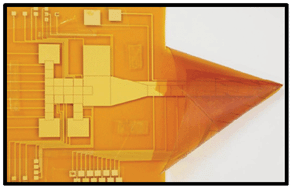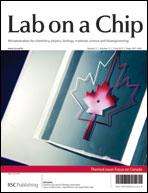Microfluidic origami: a new device format for in-line reaction monitoring by nanoelectrospray ionization mass spectrometry†
Abstract
Microfluidics is an attractive platform for chemical synthesis because it offers fast reaction times, reduced reagent usage, and the ability to integrate multiple functions on a single device. Digital Microfluidics (DMF) is particularly well-suited for microscale chemical synthesis, as it permits discretized sample handling, allowing for total process control. However, a limitation of DMF-based synthesis is analysis, which is often performed offline. To this end, we have developed “microfluidic origami”, a new device format that integrates DMF with in-line analysis by

- This article is part of the themed collection: Focus on Canada

 Please wait while we load your content...
Please wait while we load your content...